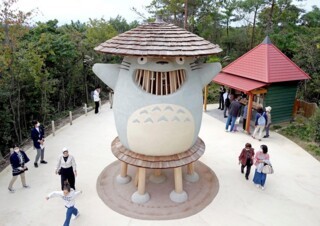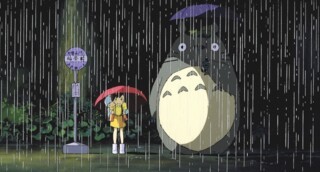At Ghibli Park
Rosemary Hill
Studio Ghibli was founded in Tokyo in 1985. Its moving spirit, the writer and director Hayao Miyazaki, is now in his eighties. His latest picture, The Boy and the Heron, won an Oscar this year for best animated feature. It was his first film since 2013 when he released The Wind Rises and announced that it would be his last. Two generations of children in Japan and beyond have grown up with the films and watched them again with – or without – their own children.
Fantastical, sometimes whimsical but not sentimental, the movies dip in and out of myth and folklore. They belong more to the world of Grimm and Perrault than Disney. Most of the children in them start from a place of difficulty which is often, but not always, resolved by the end. Parents are disposed of or sidelined early. In Kiki’s Delivery Service Kiki the young witch nervously leaves home to finish her training. The sisters Satsuki and Mei in My Neighbour Totoro move with their absent-minded father into a creepy old house to be near their mother who is in hospital. Most dramatically, in the marvellous Spirited Away, Chihiro’s parents conveniently turn into pigs.
There are fairly happy endings, but truly terrifying things happen along the way. Disney, which has distributed Ghibli films outside Japan since the 1990s, drew the line at Princess Mononoke, well described by Mark Kermode as ‘impressively violent’.
A Ghibli Museum opened in Tokyo in 2001 and tickets are constantly oversubscribed so the announcement in 2017 of plans for a Ghibli amusement park on the site of the 2005 Expo in Aichi, near Nagoya, was greeted with frantic excitement. Construction began soon afterwards with three of the five themed areas opening in 2022 and the others in spring 2024. Tickets are released in batches once a month for two months ahead and there are between three and four thousand a day. They go in a matter of hours. In line with Ghibli’s commitment to ecological sustainability there is no car parking. A shuttle bus runs from the nearest railway station. There are no refunds, no readmission and no reselling or even gifting of tickets.
It is almost the inverse of the Disney parks where you pay to have a prepared experience offered to you. At Ghibli you are left to make your own experience, playing out your memories of favourite films or scenes. There are no actors dressed up as characters: visitors are the characters, and we experience the world as if from inside the films. At Kiki’s Bakery you can buy real bread and cakes; the Dondoko Forest, home of Totoro, is a real forest which you pass through on an elevated wooden walkway. There are only a few rides: the most striking is an old-fashioned carousel which plays the theme from Howl’s Moving Castle (‘Merry-Go-Round of Life’) and revolves slowly within sight of the Moving Castle itself which is set on a hill and tilted slightly forward as if about to set off.
There is of course a lot of merchandise but, in another unusual arrangement you enter, rather than exit, via the gift shop. The Warehouse, as it’s called, is awash with toys and gifts that are all the more sought after because Ghibli doesn’t sell them anywhere except the museum and the park (and, to a limited extent, online). Also in the Warehouse are reconstructed scenes from the films, each with a key character missing. You wait your turn to step in and be the young Jiro Horikoshi, the aeronautical engineer in The Wind Rises, launching a paper dart that has turned into a plane, or Anna, standing back to back on the seashore with the ghostly Marnie from When Marnie Was There, a particularly weird story of dead mothers, lost children and fear of parents who may not be what they seem.
Everyone knows the poses as they jump into the scenes to be photographed by their friends, or queue patiently for a picture next to No Face from Spirited Away, a mostly benign but occasionally monstrous being whose most usual shape is immensely tall and thin, robed like a monk but with a blank Noh mask where a face might be. Among the souvenirs are the character hats for which I’m not sure there is an English word. Fluffy caps with faces that sit high on top of your head, they have flaps – sometimes done like ears – which you wrap round your neck or tie under the chin. In Mononoke Village, one of the two most recent areas to open, I watched a tall, elegant woman in her forties wearing a red and gold one with devil’s horns. She was alone and spent some time arranging it in a hand mirror before taking a series of careful selfies.
The presiding spirit of the park is Totoro, the pear-shaped, enormous, wordless and benign hero of My Neighbour Totoro who befriends Satsuki as she turns to the forest and its creatures to escape the unfamiliar, crumbling house and the worry about her sick mother. In one of the most affecting scenes in any of the Ghibli films, Satsuki and Mei are waiting at a bus stop in heavy rain when Totoro appears beside them with an umbrella and stops the rain (by making it fall all at once). Comforting and enigmatic, he is also the park’s oldest inhabitant as there was a giant Totoro figure in the Japanese display at the original Expo in 2005.
Other features of the site survive, including a traditional Japanese garden and some of the landscaping which has all been carefully integrated. The park is vast and some of it is turned over to horticulture. Visitors who buy a ticket for all areas are advised to come early to fit it all in, or better to come twice. Tickets are cheaper than most theme parks at Y3500 to Y7500 (£17.50 to £37.50) depending on levels of access. Once inside, the opportunities to spend on food, souvenirs or a ride on the Cat Bus (another character from Totoro) are unlimited, but you can have a pretty good day out on a basic ticket. Thousands of people do.

